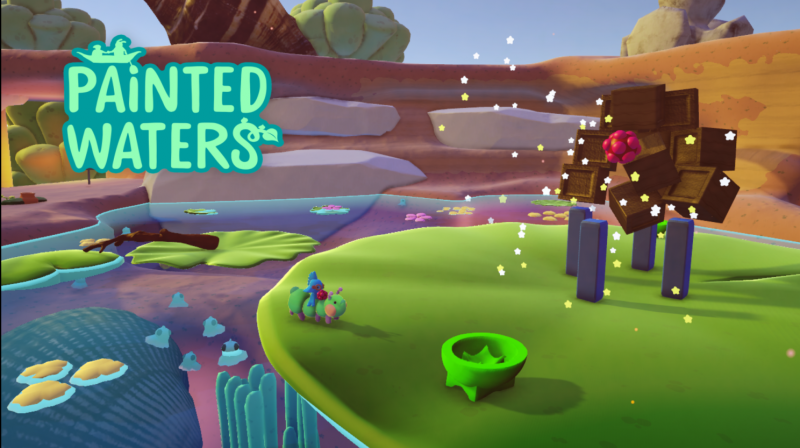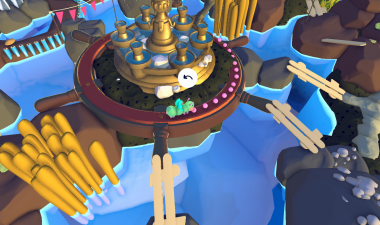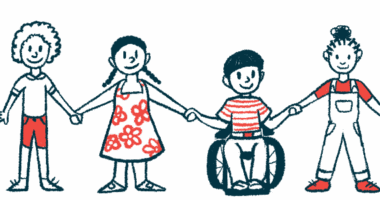‘Painted Waters’ Brings Gaming to Children With Disabilities Like SMA

Playing video games can be a challenge for people with spinal muscular atrophy (SMA). Multiplayer games may pit them against those who are able-bodied, action role-playing games force them to do multiple motions on a controller with one hand, and fighting games reward players for quick-twitch muscle moves.
Painted Waters, a free-to-play game developed by the indie studio Numinous Games with financial support from the pharmaceutical company Novartis, is an experience that seeks to surmount the hurdles kids with SMA or other disabilities have playing traditional video games.
Ryan Green, co-founder of Numinous, and his nine-person core team of contributors created Painted Waters as a one-button game that works with whichever input type a person is using, whether it be eye-tracking, a joystick, or the left button of a mouse. There’s no need to control the whimsical blue-skinned character riding a caterpillar — the game leads it for you.
All players must do to change direction, throw or pick up an item, jump, or activate the pause menu is look at one button or physically press it. Whenever a fork in the road or an object to pick up appears, the game will prompt the player to either click, gaze, or press for a particular action, or do nothing to continue on the current course.
The single-player game is designed primarily for children younger than 8 who are living with SMA, though Green says it is playable for all ages and abilities.
The open beta version of the game was released in January and is available for download on the indie game website itch.io.
“My hope was how can we make sure that the most people could play it as possible,” Green, 41, said in an interview with SMA News Today. “Our desire was that everybody could play, that we wouldn’t be building something for the SMA community, and there’d be kids left out.”
Green invites any player to ask Numinous directly for help with controller configurations or adaptations.

Ryan Green transitioned from a corporate programmer to a game designer around 2010. (Photo courtesy of Numinous Games)
Players move their character to a number of different locations on the small map, from Shaker Grass Gardens to Lollypop Cliffs to Jar Garden Hill. Each of these areas host mini-games, like Spinny Moves (a turn-based board game), Topple Tower, and mini-golf. Players also can interact with the environment by feeding minnows in the lake, talking with other frog-like creatures, and planting flowers in designated pots around the play area.
In-game settings allow a player to change interaction and movement speed so that people who need more time to hit a button, or switch their gaze between an eye tracker and the computer monitor, have ample opportunity to do so. For some actions a progress bar appears, giving the player a chance to cancel an upcoming action if necessary.
As of now, prizes earned from each of those mini-games can be used to decorate the world of Painted Waters. Green hopes that one of the activities is making art and permanently saving it on the blank canvas of the game’s world.
At the request of SMA News Today, Dominick Evans, 41, a director, screenwriter, and Hollywood consultant with SMA type 3, explored Painted Waters. He said the game is perfect for very young kids, but that older children might be bored. He compared the design and feel of Painted Waters to educational JumpStart games.
The beginning of the game was somewhat confusing, Evans said. It took him a few minutes to figure out that the goal was to explore the rest of the map and engage in smaller mini-games.

The main character automatically crawls along the pink dots unless the player touches one button to change direction. (Screenshot courtesy of Numinous Games)
Evans, however, praised the game’s accessibility-minded design. The fact that Painted Waters asked users if they were using Eyegaze at the very start was a plus for Evans. So, too, was its single-button nature. He called it a nice break after dealing with the frustration of multiplayer shooter games like Fortnite and Apex Legends, which pit him against able-bodied players and feature an array of buttons.
“We can only go as far as our bodies will let us and so when you have a game that’s just a few clicks or one click, it can be refreshing,” Evans said, adding that he appreciates Numinous’ effort for inclusivity. “They really tried [for] as many people as possible to play this game. And I think they succeeded at that.”
In designing the game, Numinous relied on feedback from Jack Freedman, a young man with SMA. He would participate in a team weekly Zoom session after playing a test version of Painted Waters. Freedman also wrote blogs for The Playability Initiative, a public project created by Numinous to start a “movement,” as Green describes it, in inclusive game design.
Freedman died in October from an “acute medical event” at age 26, according to a blog post by his father, Al Freedman.
“Continuing to make a game that Jack would be proud to share with his SMA friends is the best way we can honor the life of a young man who inspired us and gave us a reason to try harder,” Green’s wife, Amy Green, wrote in a post after his death.
Certain parts of the game continue Freedman’s legacy. He loved fountains, so they’re a central part of Painted Waters’ world. As a child, Freedman enjoyed knocking down blocks with his wheelchair. Now, players do exactly that in the Topple Tower mini-game.

Ryan Green with his son Joel, who died of a rare cancer in 2014. (Photo courtesy of Numinous Games)
Green became more involved in game development after his third son, Joel, was diagnosed at age 1 with a rare form of cancer in January 2010. Green, a former senior developer at the dialysis company DaVita, used his programming experience and help from friend Josh Larson to create the game That Dragon, Cancer. The two-hour interactive narrative journey of Joel’s cancer and the impact it had on the family was released in 2016, two years after Joel died.
The game’s release and subsequent Wired article drew attention from David Lennon, who was at the time vice president and franchise head of U.S. oncology at Novartis. Numinous and Novartis started work shortly thereafter. That partnership led Green to create another game focused on patients with neuroendocrine cancer, Galaxies of Hope, which was released in 2018. Work on Painted Waters started in 2019. Novartis fronted the cost of one year of software development, said Emily Chee, general manager, US, at the biotech company.
Novartis, which develops and markets the FDA-approved gene therapy Zolgensma (onasemnogene abeparvovec-xioi), decided to support Numinous and its development of Painted Waters to meet the needs of the SMA community, Chee said.
“My son especially loves playing video games. That’s just such a part of their childhood, whether it’s connecting, learning, or just having fun,” Chee said. Supporting “the SMA community makes us feel good about being able to be a good ally.”
That financial backing was for the project’s first phase, which ran until December 2021. Numinous is now the primary financial backer, Green said, and while it is looking for new partners, he was clear that no money would be asked of SMA families.
Because the game is in beta phase — its 31st iteration — developers are still seeking input from the community, adding more content to the game, and working out bugs. Updates are rolled out every two weeks. In a play-test by this SMA News Today writer, a number of glitches with player movement, object spawning, and dialogue required a game restart. Green said he welcomes such feedback.
“When you start making a game, it’s really easy to kind of just go heads down and focus on the creating point,” said Green, who has been working in games development since 2008. “This is an opportunity for us to kind of put our heads up and learn.”
About 140 people have downloaded the game to date. Thanks in part to Novartis’ financial support, Green has no intention of making a profit with Painted Waters, whether through ads or in-game purchases.
“We don’t want to be a financial burden, we just want it to be a place … to be creative,” Green said.
Painted Waters was designed with accessibility in mind from the ground up. Developers must consider a player’s energy levels, the time it takes for a character to traverse the environment, and the feasibility of actions such as repeated tapping. All those considerations go into the architecture of the playing space.
“It affects every level of game design,” Green said. “So it can’t be something you just do at the end.”
Green plans to continue accessible game design beyond Painted Waters. He started The Playability Initiative as part of Numinous to bring fellow developers together and create inclusive video games, tools, and experiences. That initiative also is partly financed by Novartis.
Playability’s motto is “designing for the one.” It’s the idea that designing for one person, like Freedman in the case of Painted Waters, can be helpful to many.
“As we were building That Dragon, Cancer, and as we think about the potential of video games, I think about how they can allow us to see people, allow people to express themselves, and allow us to see people for who they are,” Green said.
The post ‘Painted Waters’ Brings Gaming to Children With Disabilities Like SMA appeared first on SMA News Today.




